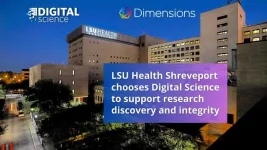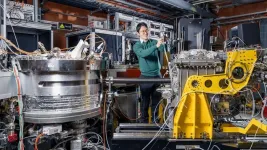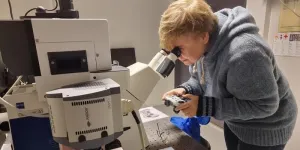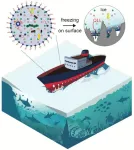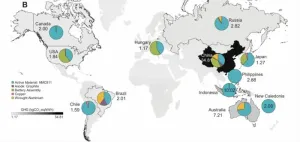(Press-News.org) November 28, 2023—(BRONX, NY)—Acute myeloid leukemia (AML) and myelodysplastic syndromes (MDS)—two related blood diseases that disproportionally strike older adults—are notoriously difficult to treat and associated with high relapse rates. Although new therapies have improved survival, treatment options remain limited, and the prognosis for the 50% of people who experience disease relapse remains poor.
Researchers at the National Cancer Institute-designated Montefiore Einstein Comprehensive Cancer Center (MECCC) were recently awarded a four-year, $2.6 million grant from the U.S. Food and Drug Administration (FDA) to conduct an innovative phase 1 clinical trial of a new drug for patients with relapsed and treatment-resistant forms of AML and MDS. It is one of only 10 grants issued this year by the FDA through its Office of Orphan Products Development.
“This is a tremendous opportunity to apply the knowledge we have developed in our MECCC labs over the past decade to develop a novel therapeutic strategy,” said Aditi Shastri, M.D., the principal investigator of the grant, a member of MECCC’s Stem Cell and & Cancer Biology Research Program and Blood Cancer Institute, and associate professor of oncology, medicine, and developmental and molecular biology at Albert Einstein College of Medicine.
Drugs that initially work against AML are ineffective when the disease returns. Research suggests that those treatments leave behind leukemic stem cells that are resistant to existing medications and lead to relapsed and drug-resistant AML and MDS.
“We have identified a molecular target in leukemic stem cells and a novel drug that performed well against those stem cells in pre-clinical studies,” Dr. Shastri said. “We are eager to see if this drug and its combinations can provide clinical benefit for our patients.”
AML and MDS are rare diseases with among the worst prognoses of all cancers: most people who develop relapsed or treatment-resistant disease live for only another 4 to 10 months. Since AML is so difficult to treat, most patients receive care at academic cancer centers. MECCC, with its Blood Cancer Institute and Stem Cell and Cancer Biology Research Program, is one of a few institutions in the country specializing in AML and MDS.
In 2018, Dr. Shastri and colleagues found that relapsed AML and MDS patients with the worst prognosis have leukemic stem cells that express excessive levels of the protein STAT3. In subsequent studies, her lab found that STAT3 does several things to help MDS and AML cancer cells survive; most importantly, STAT3 prevents cancer cells from undergoing apoptosis, known as programmed cell death—the goal of a major AML/MDS drug called venetoclax. Dr. Shastri hypothesized that blunting the impact of STAT3 could make venetoclax more effective and lead to better outcomes for patients.
Dr. Shastri then looked for compounds that specifically targeted STAT3 and identified the novel targeted drug danvatirsen: a STAT3 inhibitor developed by Flamingo Therapeutics and Ionis Pharmaceuticals that is now being developed as a cancer treatment in early-phase clinical trials. After conducting preclinical tests indicating that danvatirsen shows promise against AML/MDS, Dr. Shastri is investigating the drug in a phase 1 clinical trial.
The trial is slated to begin this month and will enroll patients with therapy-resistant MDS and AML at MECCC and MD Anderson Cancer Center in Houston, Texas. “Since this is a phase 1 trial, our first priority is to determine the safety of danvatirsen when used alone and in combination with venetoclax, as well as the optimal dosages for the two drugs,” Dr. Shastri said. “We will investigate the effect of danvatirsen, alone and in combination with venetoclax, on leukemic stem cells.”
If the researchers find evidence that the experimental treatment has clinical activity, they will expand the study to a phase 2 trial to further assess the treatment’s effectiveness. The co-principal investigator of the clinical trial is Naval Daver, M.D., at the MD Anderson Cancer Center. MECCC co-investigators on this grant are Marina Konopleva, M.D., and Ulrich Steidl, M.D., Ph.D.
The grant is titled “A phase 1 study investigating the safety & efficacy of danvatirsen as monotherapy followed by combination with venetoclax in patients with relapsed/refractory MDS & AML” (R01FD007836).
***
About Montefiore Einstein Comprehensive Cancer Center
Montefiore Einstein Comprehensive Cancer Center (MECCC) is a National Cancer Institute (NCI)-designated comprehensive cancer center and a national leader in cancer research and care located in the racially and ethnically diverse borough of the Bronx, N.Y. MECCC combines the exceptional science of Albert Einstein College of Medicine with the multidisciplinary and team-based approach to cancer clinical care at Montefiore Health System. Founded in 1971 and a NCI-designated cancer center since 1972, MECCC is redefining excellence in cancer research, clinical care, education and training, and community outreach and engagement. Its mission is to reduce the burden of cancer for all, especially people from historically underrepresented groups.
END
Digital Science, a technology company serving stakeholders across the research ecosystem, is pleased to announce that Louisiana State University Health Shreveport (LSUHS) has chosen Dimensions Analytics and Dimensions Research Security from Digital Science’s flagship products to advance its world-class research programs.
LSUHS is one of the first customers to subscribe to the new Dimensions Research Security app. The institution – one of the leading health science research programs in the U.S. – has signed a three-year deal to utilize the two products ...
INDIANAPOLIS – It is common for individuals seeking medical care for symptoms of concern to go to the nearest hospital. Physicians there may determine the facility cannot provide the care they believe the patient needs and recommend transfer to another hospital offering a higher level of care or specialized services.
In a recent study, researchers from Regenstrief Institute and Indiana University School of Medicine reviewed electronic health records to compare older adults with dementia transferred to another hospital with older adults who did not have dementia. The researchers found significant differences in treatment following transfer.
Patients with dementia more ...
Scientists have revealed how lattice vibrations and spins talk to each other in a hybrid excitation known as an electromagnon. To achieve this, they used a unique combination of experiments at the X-ray free electron laser SwissFEL. Understanding this fundamental process at the atomic level opens the door to ultrafast control of magnetism with light.
Within the atomic lattice of a solid, particles and their various properties cooperate in wave like motions known as collective excitations. When atoms in a lattice jiggle together, the collective excitation is known as a phonon. Similarly, when the atomic spins - the magnetisation of the atoms -move together, it’s ...
Far too many antibiotics are used around the world. As a result, bacteria are becoming resistant.
Curing bacterial diseases is becoming more difficult than before, because antibiotics are perhaps our foremost weapons in the fight against them.
An important step towards using fewer antibiotics is to find better methods for identifying pathogens, and here is the good news.
“We have developed a simple tool that can identify all of the genetic material in bacteria. This allows us to find out more quickly what kind of bacteria a sick person or animal is affected ...
As Americans gear up for winter, many will face one of their toughest foes: ice. From delaying flights to making roads slippery, ice accumulation on surfaces wreaks havoc in many ways.
But not all ice is created equal. In new research from the University of Illinois Chicago, scientists studied the stickiness of ice containing everyday contaminants such as salt, soap and alcohol. Most laboratory studies typically test ice made from pure water, but in nature, ice is seldom pure.
“Be it dirty sidewalks or the hull of ...
Philadelphia, November 28, 2023 – Researchers from Children’s Hospital of Philadelphia (CHOP) found that seizure patterns and response to treatment strategies were able to help clinical teams determine epilepsy and developmental trajectories for patients with STXBP1-related disorders, one of the most common genetic epilepsy disorders. The findings were published online by the journal Brain.
Disease-causing variants in the gene STXBP1 are implicated in one of the most common genetic epilepsies and neurodevelopmental disorders, which are sometimes accompanied by autism spectrum disorder, increased or decreased muscle tone, or movement disorders. ...
An international study group led by researchers of Children’s Hospital of Philadelphia (CHOP) have identified how three novel genes cause neurodevelopmental disorders. Researchers now have a better sense of the genes’ roles in human brain development and function and their ability to serve as potential therapeutic targets in the future. The findings were recently published online by the Journal of Clinical Investigation.
Over the last couple of decades, researchers have identified more than 1500 genes in different signaling pathways associated ...
DALLAS, November 28, 2023 — Cardiovascular disease (CVD) claims more lives than all forms of cancer, yet many women, particularly younger women, remain unaware.[1] Through its Go Red for Women® movement, the American Heart Association, which is devoted to a world of healthier lives for all, is being supported by Miss America’s Scholarship Foundation to empower the next generation of women to take charge of their health and make a lasting impact on the health and well-being of communities nationwide.
The ...
Nanodiamonds are 2-8 nm carbon nanoparticles, which can be easily functionalized with various chemical groups like carboxylic groups or drugs. Previous research has shown that actively dividing cells are more likely to absorb nanodiamonds and that epithelial cells treated with carboxylic nanodiamonds lose the ability to migrate across cell permeable cellulose membranes. Rajiv K. Saxena and colleagues explored whether nanodiamonds might block tumor metastasis, a process that requires cell migration to new areas. The authors treated B16F10 melanoma cells with carboxylic nanodiamonds in culture and tested their ability to migrate and ...
Decarbonization of the global economy will require the production of a large number of batteries for electric vehicles (EVs). However, these batteries require energy and an array of minerals to produce and are not without their own environmental impacts. Fanran Meng and colleagues trace the energy consumption and greenhouse gas emissions in the global productions and supply chains of two common battery technologies as well as their future variants: nickel-manganese-cobalt (NMC) and lithium-iron-phosphate (LFP). Today, two-thirds of battery-related emissions occur in China (45%), Indonesia (13%), and Australia (9%), in part due to emissions-intensive electricity for ...


